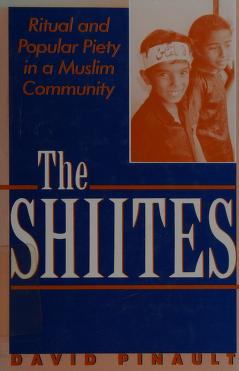The Shiites; ritual and piety in Muslim community
 | |
| Author | David Pinault |
|---|---|
| Language | English |
| Genre | sociological and cultural |
| Published | 1992 |
| Publisher | British Academic Press |
| Pages | 272 |
The book The Shiites; ritual and piety in Muslim community is a sociological and cultural work in which the author deals with some intellectual, cultural and ethnic characteristics of the Shiite school.
About the author[edit | edit source]
David Pinault, Ph.D., is a Professor of Religious Studies and the Director of the Arabic, Islamic, and Middle Eastern Studies program at Santa Clara University. He received his B.A. in French literature from Georgetown University and his M.A.& Ph.D. in Arabic and Islamic Studies from the Department of Oriental Studies at the University of Pennsylvania. His research interests include comparative Christology and the status of Christian populations in Muslim-majority societies. His most Popular Books: The Shiites, Museum of Seraphs in Torment: An Egyptological Fantasy Thriller, Horse of Karbala: Muslim Devotional Life in India, Notes from the Fortune-telling Parrot: Islam and the Struggle for Religious Pluralism in Pakistan, The Crucifix on Mecca's Front Porch: A Christian's Companion for the Study of Islam
About the book[edit | edit source]
This book published by British Academic Press (31 December 1992), has 272 pages.
The book has 18 chapters in three main parts that examines the South Asian community in the month of Muharram and commemorates the tragic events that led to the martyrdom of Hussain, the Prophet’s grandson.
Abstract of chapters[edit | edit source]
Part I, An Introduction to the Shiite Tradition in Islam[edit | edit source]
This section is a general introduction to Shiism and its differences from the Sunni school. The author introduces here one of the features of this school called esotericism and interpretation which is of special importance. He discusses the worldviews and interpretations of sacred history elaborated by Shiites of later generations who meditated on the persecutions suffered by the Prophet’s family. In the process he describes briefly the various denominations of Shiism (Twelver, Ismaili, and Zaydi) as well as the heterodox sects known collectively as the ghulat or “doctrinal extremists.’’
The first 7 chapters of the book in this part deals with the following issues:
- Despite important differences between Shiite and Sunni, there are common religious beliefs and fundamental insights into the nature of divinity and God's relationship with humanity and these differences are in practice far more than in theory.
- The interpretation of the Qur'an and the order in the Muslim community and important Qur'anic events such as the sacrifice of Ismael by Abraham are mentioned.
- Important features of the Shiite school in the works of Hafez, Attar and Suhrawardi are presented.
Part II, Ritual and Popular Devotion in a Shiite Community: Muharram Liturgies of Hyderabad[edit | edit source]
In second part the author goes to the Shiite community and deals with the two issues of Shiite shrines in ancient cities and the sociology of Shiites in Hyderabad, India. He studies the issue of Muharram and the mourning of Shiites and their relations with the followers of other religions. The focus of this part is on the most intense period of mourning, the first ten days of Muharram, but the period of tears extends throughout all of Muharram and beyond into the following month of Safar; in a sense Muharram casts its shadow over the whole year, in other words, The wrong committed at Karbala is too great ever to be set aside completely.
In 11 chapters of this part, the author deals with the following issues:
- Examines the holy ceremony of Muharram in different Shiite areas of Hyderabad
- Describes shrines or ashurkhanas that hold religious ceremonies
- Focuses on men's associations and their functions
- Notes some examples of popular Hyderabad guilds and associations and describes their activities
- Analyzes one of the activities related to the men's guild organization (matami guruhan): the performance of matam, actions of mourning or condolence (chest-beating and/or self-mortification involving weapons). Matam is generally performed in a group liturgical setting and is performed in time to a rhythm determined by the chanting of a nauha or lamentation poem. It was criticized for its methods of beating, but defenders in response to criticism, emphasized the importance of intention.
- Mourning was the subject of controversy among Hyderabadi Muslims (mostly Sunnis) in Hyderabad, and this criticism was against religious practices rather than against the guruhan themselves.
Part III, Conclusion[edit | edit source]
In this part, chapter 19, by summarizing the contents, Pinault discusses general issues entitled the Shiite international community. At the end, he mentions the Islamic Revolution of Iran and the role of the Karbala incident in the formation of the Khomeini movement.